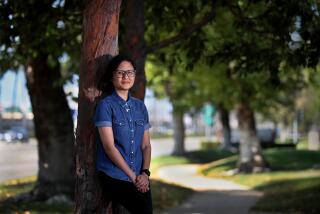Center’s ‘Kitchen’ Mixes Up Recipes for Life
- Share via
ESCONDIDO — At the age of 6, Christina Hale has yet to eat her first full meal. Since birth, her nourishment has come in the form of a chalky-white liquid delivered through a plastic tube that runs into her nostril and down her esophagus.
It is a sacrifice that she and her parents are very willing to make. Without the carefully calibrated liquid diet and feeding regimen developed at a special research center at UC San Diego Medical Center in Hillcrest, Christina probably would not be alive.
Christina is a victim of methylmalonic acidemia, a rare disorder that usually kills children who lack the enzyme needed to break down methylmalonic acid, a byproduct of protein metabolism. The substance accumulates in their tissues soon after birth, causing coma and, ultimately, death.
As one of the oldest living persons with the disease, Christina is an example of the progress made under a new therapy developed by a UCSD physician and the value of the precise skills in use at the hospital’s specialized “metabolic kitchen.”
It is there that researchers and nutritionists test Christina and children with other metabolic disorders to devise dietary regimens critical to their health and to advance medical knowledge of these kinds of diseases. In Christina’s case, for example, there is no known medical treatment. Her diet is, quite simply, all that keeps her disease in check.
“She is an example of the success of this program,” said Dr. Orville Kolterman, program director of the General Clinical Research Center, which includes the kitchen. “Ten or 15 years ago, those children had a miserable existence, and they almost uniformly died. And the ones that didn’t die were severely growth retarded because of the severely restricted diets they felt they had to be on to survive.”
The $1.8-million research center includes an eight-bed ward, 12 specially trained nurses, an outpatient facility at the UCSD medical school in La Jolla and a small laboratory. The center is one of 78 across the nation funded by the National Institutes of Health.
Its mission is diagnostic and therapeutic research in nutrition, metabolic diseases, oncology, reproductive medicine, hypertension and diabetes, Kolterman said. Patients like Christina are treated as part of ongoing research into metabolic diseases. For example, Christina’s physicians have published five papers based on research conducted with Christina.
Knowing What’s Eaten
Other faculty members at UCSD have access to the research center and the metabolic kitchen. A university psychiatrist is studying a possible link between sodium in diets and levels of stress and anger. The research is using some transients as subjects, which has the added value of giving them a warm bed and good food for a few nights while they are in the hospital.
Kolterman is seeking subjects for participation in a nationwide 10-year study to determine whether a tightly controlled diet and various insulin regimens can slow the progress of diabetic retinopathy, which leads to blindness in diabetics.
Still other researchers are using extremely high-fat diets to control seizures and malnutrition among girls with Rett syndrome, a recently discovered and little-understood disorder.
“There are many investigations that require patients to be on very specifically defined diets,” Kolterman said. “It’s important for the researcher to know exactly what the patient is eating.”
Christina’s disease is a perfect example. The problem facing her and her doctors is this: Because of the missing enzyme, her system does not break down methylmalonic acid when metabolizing four specific amino acids contained in protein. But because the amino acids are essential for life, she must consume them to grow.
The treatment is to give her just enough protein to sustain growth, but not enough to make her ill.
“If you don’t give her enough, you’re in trouble from that direction, and the minute you give too much you’re in trouble,” said Dr. William Nyhan, Christina’s physician and a world-renowned specialist in metabolic disorders. “So you have to walk a very difficult tightrope.”
Precise Measurements
How precise must the measurements be? According to Nancy Stubblefield, a research associate at the kitchen, a difference of five grams of protein over a period of time could make a grave difference. That is about the amount of protein found in one ounce of meat.
“Let’s say her requirement is 20 to 25 grams of protein per day,” Stubblefield said. “If she got to 30, or even to 26 or 27, and consistently had that day after day, she would probably get sick. You’re talking about a five-gram difference, and that’s not much when it comes to food.”
Instead of solid food taken by mouth, Christina lives on the complicated formula of nutrients and water devised by researchers and nutritionists in the metabolic kitchen. Her mother has been taught how to mix up the recipe, which is “like baking a cake every morning,” Stubblefield said.
But preparing the correct mixture is only half the battle. Christina must receive precise amounts at regular intervals, and the formula must be dripped into her system at a specified rate. An electric pump is used to regulate the rate, but if the regimen is not followed, Christina runs the risk of becoming ill or vomiting the mixture, in which case she must be fed again. In addition to her mother and father, a nurse at her school, Nicolaysen Center in Escondido, has been taught to feed her.
The illness has caused Christina to vomit frequently. Because it is essential to know precisely how much food she has taken in, every piece of her clothing and all her bedding is weighed when she enters the hospital. When she vomits, the article of clothing or sheet is weighed again to determine how much food she has lost.
Every six months, Christina is re-examined in the hospital, where researchers re-calculate the diet based on measurements of her excretions and test it out on Christina. The final measurements of the protein mixture are largely the result of trial and error. Each adjustment differs because Christina is still growing.
“We don’t know because she’s so unique,” said Dr. Bruce Barshop, another physician treating Christina. “We’re making it up as we go along, really.”
A 16-year-old Miami girl is the oldest living child with Christina’s form of methylmalonic acidemia known to Lorie Asten, coordinator of the Organic Acidemia Assn. in Kansas City, Kan. Asten said that there may be other victims who are not members of her 4-year-old organization, which includes 300 families and care providers.
Family Members
The Hales’ second child, Chris, died in 1976 at the age of three months from the same disease. When Elizabeth became pregnant with Christina in 1980, amniocentesis revealed that she also had contracted the disorder. But the Hales chose not to abort the pregnancy because of their religious beliefs.
The couple has two other daughters, 8-year-old Elaine, who is a carrier of the genetically linked disorder, and 12-year-old Mary Ellen, who has not yet been tested. But neither of them has the disease.
If Elaine decides to have children, her husband must be tested to determine whether he is carrying the gene. If he is, each of their children has a one in four chance of being born with the disease.
Although the exact incidence of this disease is not known, Nyhan estimated that one in every 100,000 to 200,000 children born will have it.
The Hales moved from Corona to Escondido just after Christina’s birth to be near the UCSD clinical research center, where Christina spent her first two years struggling for life with an immune system compromised by her low-protein diet. At the age of 4, Christina broke both her legs, which were made brittle by osteoporosis, in separate falls.
“She has been through times where we thought she was close to the end because of the way she looked,” Stubblefield said.
“It’s been hard,” said Elizabeth Hale. “It still is. But not as much as the first two years.”
Though she has had to learn how to connect Christina’s nasogastric tube as well as perform specialized skin care and bathing techniques, having her daughter at home became of paramount importance.
“I didn’t want her in that hospital any longer,” said Christina’s father, Steve Hale, head custodian at Central Elementary School. “She belongs home. She doesn’t belong with a nurse.”
Survival Chances Increase
If there is a bright spot to Christina’s disease, it is that its victims grow hardier with age. Her chances of survival increase each year, doctors said.
Although she will always have to be assessed periodically to determine the correct amount of protein she should consume, Christina should be able to eat a fairly normal vegetarian diet as an adult. She now takes some food orally as her parents attempt to wean her from the nasogastric tube feedings.
Christina has also developed an assertive “fighter’s” personality from the ordeal.
“She’s different from our other girls,” Elizabeth said. “She tells people what to do. None of my other girls are like that. They’re shy.”
The Hales say that the illness has brought them all closer together and that their daughters are more accustomed to some of life’s realities, such as the death of their brother.
“It can bring you down or raise you up,” Steve Hale said. “And she has raised us up.”






